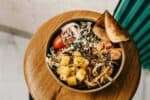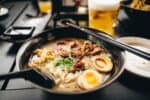If you’ve dabbled in Japanese cuisine you may have run across the terms Nabemono and Sukiyaki and may be curious about their relationship. Both Nabemono and Sukiyaki refer to traditional Japanese one-pot stews or soups that are served hot.
Nabemono, sometimes shortened to nabe, is a category of traditional Japanese one-pot dishes that are often prepared and served at the table. Sukiyaki is a type of nabemono dish which includes vegetables, soy sauce, sugar, mirin, and meat cooked slowly in an iron pot at the table.


Japanese food and cooking terms can be complicated, so if you are interested in making your own traditional dish at home, you’ll want to study up on both Nabemono and Sukiyaki terms and techniques. It is important to understand the ins and outs of both terms, as well as the equipment needed to create these dishes.

Here’s my guide on: Making Nabemono At Home.
Nabemono: One-pot meals
Nabemono is a category of one-pot dishes that encompasses Sukiyaki and other types of stews and soups. There two main types of nabemono that these one-pot dishes fall under.
The first type included a very lightly flavored stock in the recipe and is served with a secondary dipping sauce. The second type includes a strongly flavored stock that is served without a dipping sauce.
Nabemono soups and stews typically include a combination of vegetables, meat, tofu, or seafood that are all simmered in a flavored broth in the same pot. In some instances, this dish is finished off with rice or noodles such as ramen or udon.

Many Nabemono soups can also be enriched by local produce and ingredients, which creates even more possibilities for unique and diverse flavors.
Some popular Nabemomon soups are:
- Oden – boiled eggs, daikon, konjac, and processed fishcakes stewed in light dashi broth
- Yose Nabe – a flexible and basic nabe made from any combination of meat, vegetables, and broth on hand
- Chanko Nabe – protein-heavy meats, tofu, and vegetable in a dashi broth. This dish is traditionally served in bulk to sumo wrestlers
- Chicken Mizutaki – chicken, chicken meatballs, and vegetables such as cabbage and leeks boiled in kelp-soaked water.
- Motsu Nabe – tripe, cabbage, and garlic chives in a base of soy sauce, garlic, chili pepper, or miso. This dish is often finished with noodles.
- Ishikari Nabe – a creamy nabe with salmon and miso. This nabe is a specialty of Hokkaido.
- Fugu Nabe – fugu, or pufferfish, meat and skin, simmered with vegetables in a light dashi broth flavored with kelp.
- Anko Nabe – anko, or anglerfish, meat, seasonal vegetables, and a simple miso or soy sauce flavored broth
- Shabu Shabu – a unique nabe where the water boils first and you choose ingredients to cook one at a time, similar to fondue.
- Sukiyaki – thinly sliced meat and vegetables in a broth of soy sauce, sugar, and mirin
These dishes are designed with community in mind and are often prepared and served from the same pot in the center of the table. Nabemono can be fully prepped ahead of time so that the preparer can focus on time with family or guests while the food simmers.
Nabemonos can also be cooked in any heavy-duty pot over a stove or in a ceramic donabe pot and portable gas burner. If you’d prefer a more modern cooking vessel, you can also invest in an electric skillet to keep your nabemono at the center of your table.
For serving your nabe, it can be useful to have both a ladle for broth and a slotted spoon for ingredients. This will ensure that everyone enjoying the nabe gets the proportion broth to ingredients that they would like.
Now that you are familiar with the different types of nabemono, let’s take a closer look at what sets the sukiyaki apart from the other nabes.
Sukiyaki

Sukiyaki differs from other nabes because it requires special preparation of the meat and the use of eggs.
In many nabe recipes, there are no instructions for how your meat should be prepared. Sukiyaki, however, requires beef, and occasionally pork, that has been thinly sliced before cooking. Meats and vegetables are typically dipped in the raw beaten egg after they have been cooked, just before they are eaten.
Though there are many different regional styles of this sukiyaki, there are two that are most popular. In Kanto style, the broth is added to the pot first, and in Kansai style, the meat is added to the pot and cooked before the other ingredients are added. In both versions, the meat and ingredients are dipped in a beaten egg after they have been cooked.
Both versions also favor the high-quality wagyu beef over kobe or any other types of beef. Because this can be expensive, this can lead to small quantities of meat in the recipe. Read this to get the most out of your Wagyu.
If you are shopping at a Japanese grocery store, you will likely find this beef in the meat section, pre-sliced. Otherwise, you should be prepared to slice the beef on your own.
As with all nabes, the ingredients vary based on location and season, but there are some ingredients that are typical of most Sukiyaki dishes:
- Thinly sliced meat. Beef is the most popular type of meat. Pork, and occasionally chicken, can also be used.
- Tofu
- Scallions
- Leafy vegetables, such as cabbage
- Mushrooms, such as shitake
- Glass noodles, such as konnyaku
- Raw eggs
- Boiled rice cakes
- Mixture of soy sauce, mirin, and sugar
Sukiyaki is traditionally prepared in an iron pot, rather than a ceramic donabe. This improves your ability to sear the meat before adding in the other ingredients if you are using the Kansai style of preparation.
Typically, this dish is prepared and served in the center of the table, with each diner selecting their ingredients from the pot, dipping their meat or vegetables in raw egg, and then eating.
This communal style of dish is best enjoyed among a group of friends or family.
If it is your first time preparing a sukiyaki dish, it may be helpful to use an official recipe to get you started. It can be helpful to get guidance on specific steps and equipment when you are preparing these dishes.
If you are looking for in-depth instructions for making your own Sukiyaki and other popular nabes, you can check out this recipe book.
Preparing your Nabemono and Sukiyaki
If you are interested in making your own version of a Nabemono, including Sukayki you can follow the general steps below to make almost any nabe dish you want:
- Determine what type of nabe you’d like to make and gather your ingredients. You can use a pre-existing recipe, or you can create one on your own. In general, nabe recipes are loose, so feel free to get creative with your ingredients.
- Slice your ingredients into small pieces. You’ll want to aim for thinly sliced meat and bite-sized veggies. This helps in serving and in cooking the ingredients evenly and quickly.
- Prepare your stock. Whether you purchase a premade stock or you are making one of your own from scratch, you’ll want to get your stock in the pot first. If you are preparing sukiyaki in the Kasai style, you’ll cook your meat first instead.
- Add the rest of your ingredients to the pot, place the lid on, and begin to heat up your dish. You’ll want the ingredients to cook at a steady simmer.
- Once the ingredients are cooked, you’re ready to eat. If you are unsure about the temperature of your meat, you can use a meat thermometer to test before you dig in. For some styles, you can scoop the ingredients and broth into a bowl, while for others you’ll dip your cooked ingredients in a finishing sauce or a beaten egg before eating.
- If you’d like to finish off your dish with udon noodles, ramen, or rice, you can add these to the broth and let them simmer until they are fully cooked.
Because these classic dishes have been around for so long, it can be difficult to pin down when they became popular. Nabemono dishes have been around since the Edo period of Japanese history.
These dishes are thought to have originated during the cold seasons when typical homes had one stove to cook on. These dishes could be enjoyed by the family while the fire from the stove heated the house. Although these communal dishes are still popular during the colder months, they are also eaten year-round.
These dishes are now served at tables, and diners typically use chopsticks to enjoy. If you or any of your other diners are not proficient with chopsticks, make sure to have a variety of other serving utensils on hand.
Ladles, forks, spoons, and slotted serving utensils can be used to help serve.





























